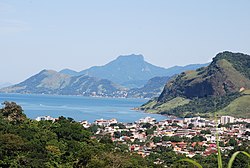Muriqui
Vila Muriqui | |
|---|---|
District | |
 Panoramic view of Muriqui | |
 Location in Mangaratiba | |
| Coordinates: 22°55′33.8″S 43°56′52.2″W / 22.926056°S 43.947833°W | |
| Country | |
| State | |
| Municipality/City | |
| Established | c. 1597 |
| Incorporated (district) | 1 December 1949 |
| Named for | Muriqui spider monkeys |
| Area | |
| • Total | 38.0268 km2 (14.6822 sq mi) |
| [a] | |
| Elevation [2] (Posto de Saúde Muriqui) | 5 m (16 ft) |
| Highest elevation | 1,226 m (4,022 ft) |
| Lowest elevation [2] (Praia de Muriqui) | 0 m (0 ft) |
| Population (2010)[1] | |
| • Total | 10,241 |
| • Density | 269.31/km2 (697.5/sq mi) |
| Demonyms | Vila-muriquiense; muriquiense |
| Sex ratio (2010) | |
| • Female | 5,225 (51.02%) |
| • Male | 5,016 (48.98%) |
| Time zone | UTC−3 (BRT) |
| Website | www |
Muriqui (also known as Vila Muriqui) is a district[4] of the municipality of Mangaratiba, located within the Greater Rio de Janeiro, Brazil. It is part of the Green Coast. Highway BR-101 passes through the district.
The district has a patron saint, the Blessed Virgin Mary (Portuguese: Nossa Senhora das Graças).[5] Since the 1950s, the local parish has celebrated annually on the 27th of November, the date Catherine Labouré reportedly had a vision of her in 1830.[6]
- ^ a b c "IBGE | Censo 2010 | Sinopse por Setores". IBGE. Retrieved 2020-02-13.
- ^ a b c "Modelo Digital de Elevação - MDE". IBGE. Retrieved 2020-02-13.
- ^ "Plano de Manejo da Área de Proteção Ambiental de Mangaratiba". Rio de Janeiro: INEA. 2015-09-11. Retrieved 2020-02-16.
- ^ "Muriqui | Prefeitura de Mangaratiba". Archived from the original on 2020-01-12. Retrieved 2020-02-10.
- ^ "Festa da padroeira de Muriqui, movimenta fim de semana" [Celebration of Muriqui's patron saint drives weekend]. Jornal Litoral (in Brazilian Portuguese) (5th ed.). Mangaratiba. December 2015. p. 10. Retrieved 2020-12-18 – via Issuu.
- ^ Cite error: The named reference
iabwas invoked but never defined (see the help page).
Cite error: There are <ref group=lower-alpha> tags or {{efn}} templates on this page, but the references will not show without a {{reflist|group=lower-alpha}} template or {{notelist}} template (see the help page).
